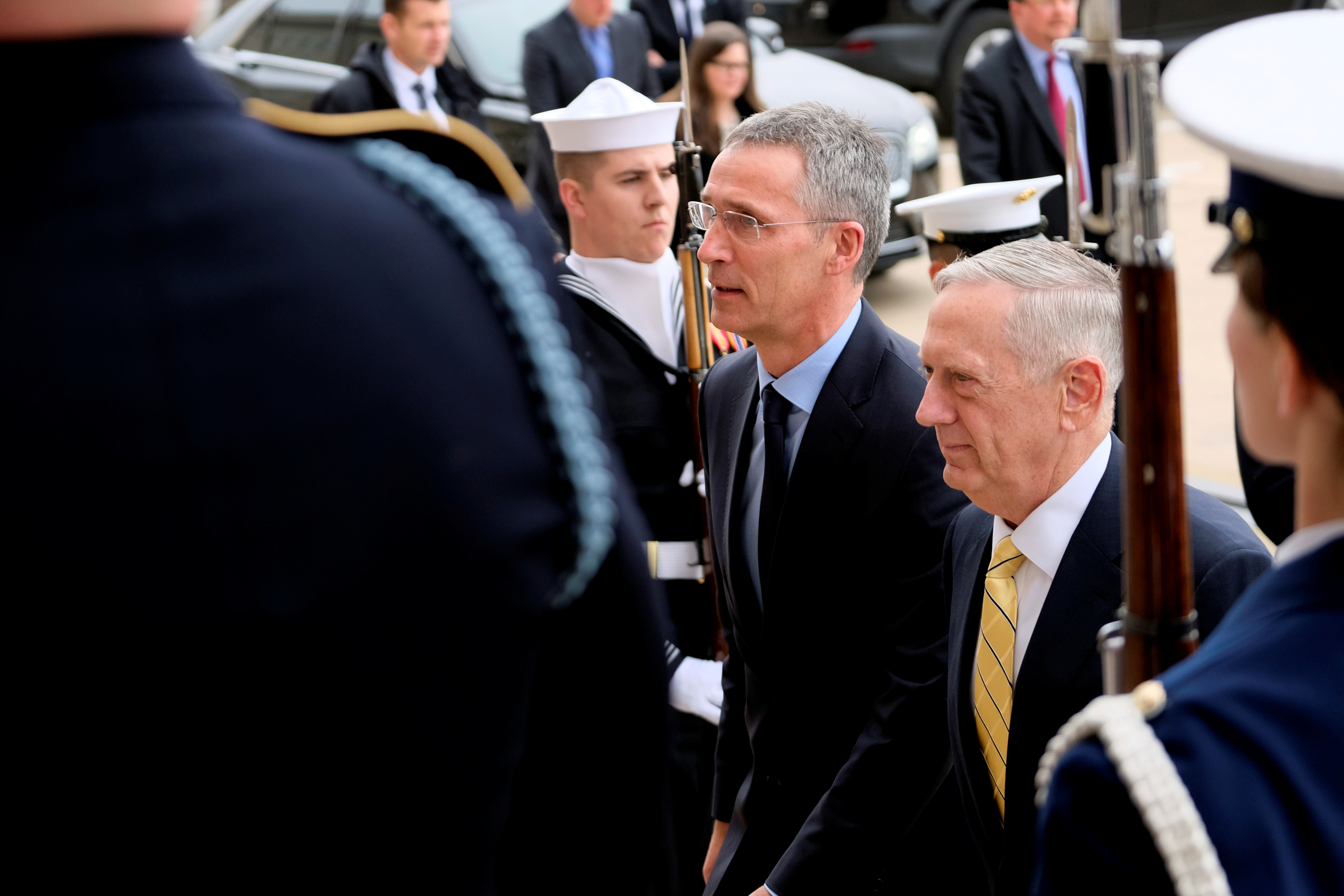U.S. Policy towards NATO: Continuation with Risk of Change

The first two months of Donald Trump’s presidency did not bring radical changes to U.S. policy towards NATO. Trump himself declared strong support for the Alliance, contrary to many of his earlier remarks. In line with Trump’s campaign rhetoric, the U.S. has, however, strengthened calls for increased European defence spending, and for NATO to be better adapted to fight terrorism. Both issues, along with policy towards Russia, are likely to dominate the talks at the meeting of heads of states and governments of NATO countries in Brussels on 25 May.
Defence Spending in NATO
At the meeting of NATO defence ministers (15–16 February), the U.S. called for the adoption of a plan for all Alliance members to meet the goal of spending at least 2% of GDP on defence by 2024. The timetable would therefore strengthen the pledge made by all NATO members at the 2014 Wales summit. The U.S. position is that nations which have already announced that they will reach the 2% goal should accelerate their efforts, while others should establish such plans. U.S. Secretary of Defence James Mattis underscored the important role of Estonia, Greece, Poland and UK, the only NATO countries that meet the 2% goal apart from the United States, in motivating other Allies to rise their defence expenditures. The U.S. also continues to stress the need for greater involvement by European Allies in joint operations, and adequate investments in modern military capabilities.
Previous U.S. administrations and Congress also criticised the imbalance in burden-sharing in the Alliance, with the U.S. currently accounting for around 68% of combined NATO defence spending. It is, however, the first time that the U.S. warned it might moderate its commitment to NATO (albeit without outlining specific consequences) if there is no progress on defence expenditures. Still, the political will to increase such spending in Europe is clearly limited. The downward trend in total defence expenditures in Europe and Canada stopped in 2015, then spending grew by 3.8% (around $10 billion) in 2016. But specific plans to reach 2% of GDP in the coming years have so far been presented only by Romania (to meet the goal in 2017), Lithuania and Latvia (both to meet the goal in 2018).
Relations with Russia
Trump’s declarations during his presidential campaign, and the first signals from his close aides as President, suggested the desire for a swift improvement in relations between the U.S. and Russia. Even before Trump took office, Michael Flynn, who later became his national security adviser, had reportedly hinted at prospects of the U.S. lifting sanctions, during informal talks with the Russian ambassador. At the turn of January and February, shortly after Trump’s inauguration, White House officials, including Vice-president Michael Pence, publicly suggested the possibility of lifting sanctions in return for Russia’s cooperation in the fight against terrorism.
In February and March, a number of Trump administration officials, including Pence and Mattis, announced that the U.S. will engage in dialogue with Russia from a position of strength. As during Obama’s presidency, the U.S. is to demand the return of Crimea and the implementation of the Minsk Agreements, while a return to partnership and military cooperation between NATO and Russia will be possible only if the latter abides by the NATO-Russia Founding Act. Such position is widely supported in Congress.
These statements might imply a hardening U.S. position towards Russia, but it is not clear whether Trump himself has given up on quickly improving relations. Even after Flynn’s resignation in the middle of February, caused indirectly by his earlier contacts with Russian diplomats, the U.S. President confirmed his desire to make a new political agreement with Russia. He stressed, however, that his political opponents and media make achieving this goal difficult, especially in the context of controversies related to Russian meddling in the U.S. presidential election. Trump’s flexibility in seeking better ties with Russia is also constrained by Russian actions, such as the violation of the Intermediate-range Nuclear Forces (INF) Treaty. In February, Russian aircraft also buzzed a U.S. destroyer in the Black Sea.
Strengthening NATO’s Eastern Flank
Officials in the Trump Administration have confirmed further U.S. involvement in strengthening NATO’s Eastern Flank, including the deployment of a U.S.-led Allied battalion-sized battlegroup to Poland in April. In line with earlier plans, the U.S. has also deployed an armoured brigade combat team (ABCT) in Central and Eastern Europe, including Poland, under the European Reassurance Initiative (ERI). Nonetheless, no references have been made to ERI funding after 2017. It amounts to $3.4 billion in current fiscal year, which ends on 30 September. Only part of that sum is included in the funding act called a continuing resolution that expires by 28 April. Remaining funds will become available after Congress passes the full 2017 defence appropriations bill. Levels of ERI funding proposed by the Trump Administration for 2018 should be included in final draft of the next defence budget by the end of May. In 2018, the U.S. is also to adopt a new National Defence Strategy (NDS), which will add more detail to Trump’s promises to reverse the cuts in the U.S. military that took place during Obama’s presidency. Moreover, in 2018 the U.S. should also complete the Ballistic Missile Defence Review (BMDR), which will be important in the context of the U.S. missile defence system in Europe (the European Phased Adaptive Approach, EPPA). So far, the Trump Administration has made no reference to the future of EPPA, including the site in Redzikowo, which is currently under construction and was originally scheduled to become operational in 2018.
The Fight against Terrorism
So far, NATO has been supporting the international coalition against the Islamic State (IS) through AWACS surveillance flights which started in October 2016. The Alliance has also been engaged in building the capacity of Iraqi security forces, including by training Iraqi army officers. NATO’s role in the fight against IS is thus limited, although all NATO countries make contributions of different scale and character to the United States-led coalition. As the swift defeat of IS was one of Trump’s campaign promises, NATO and its members should expect further requests for greater involvement in the fight against terrorism, which under the Trump administration already have included improvement of intelligence sharing, efforts to cut-off terrorist funding, and enhancement of cyberdefences, along with the acceleration of U.S. military operations in Syria and Iraq. Moreover, the U.S. could possibly call for the NATO Resolute Support training mission in Afghanistan to be strengthened, as sought by American military commanders.
Conclusions
U.S. pressure might lead to an accelerated increase in defence spending in Europe, but it is unlikely that the 2% goal will be reached by most NATO countries in the coming years. Many nations point to their unstable financial situations or argue that 2% of GDP is not an adequate measurement of burden-sharing because it does not take into account various factors such as the quality of each state’s military capabilities, contributions to the Alliance’s missions and operations, and spending on non-military aspects of security. Instead of greater defence expenditures, some countries emphasise the need for more effective allocation of existing and future funds through closer defence cooperation, especially within the EU. These factors will impede the talks on the spending timetable sought by the United States. It cannot be ruled out that the U.S. may reduce its contributions to NATO operations, structures and common budget, and scale down its military presence in Europe, including on the Eastern Flank, if the Alliance fails to adopt and implement the plan.
Still, even incrementally increasing defence spending and greater involvement in the fight against terrorism by NATO and its members could be seen by Trump as a personal success, and thus influence his perception of the Alliance in the longer term. It would be favourable for NATO’s political cohesion if increased defence spending were tied to investments in high-end military assets, leading to a tangible enhancement of European deterrence and defence capabilities. Congress would be likely to support such an approach. In any case, the U.S. will probably demand greater Allied involvement, including from Poland, in the fight against terrorism. One example might involve Kuwait-stationed Polish F-16 fighters in combat operations, in addition to continuing reconnaissance flights. It is of key importance to ensure that NATO’s adaptation to terrorist threats will be balanced, so that it will not weaken the ability to defend the Eastern Flank. The U.S. might also call for more Allied participation in covering the costs of the U.S. military presence in Europe.
The prospects of an agreement between the U.S. and Russia that would harm European interests faded with increasingly tough statements from some key members of the Trump administration on the country’s policy towards Russia. Trump’s room for manoeuvre is also constrained by the positions of a significant number of members of Congress. However, there is still a risk that Trump might take a political decision that would limit the U.S. role in strengthening the Eastern Flank in return for Russian cooperation in the fight against terrorism. This could include limiting the scale of ERI or revision of the EPAA schedule. Changes in either project would undoubtedly be reflected in future budget and strategic documents. Such a shift would indicate that the U.S. is ignoring failed past attempts to “reset” relations with Russia and the divergence of U.S. and Russian interests in Syria, as well as the fact that Moscow views the fight against IS as an instrument to further its own goals. Moreover, backing away from strengthening NATO’s Eastern Flank would also hamper the chances of effective dialogue with Russia, which should be underpinned by a credible deterrence policy.


